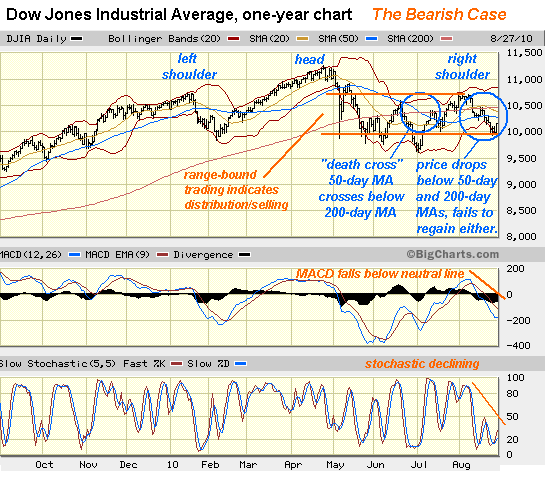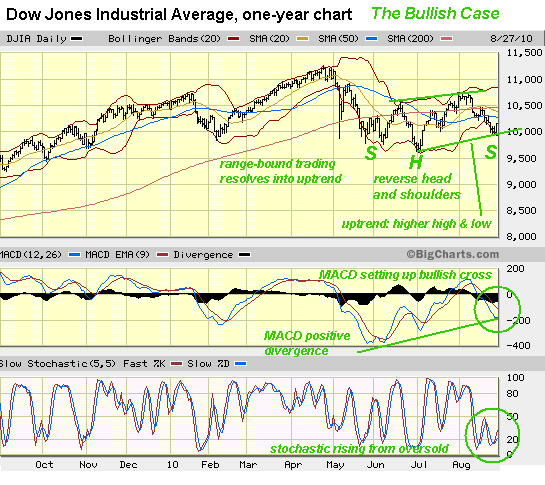The Bullish and Bearish Cases for Stocks
The financial news and general stock market sentiment are negative; in a contrarian fashion, that sets the stage for an "unexpected" rally.
The stock market is at an interesting juncture right now as an epic battle between Bulls and Bears has left the market volatile and range-bound since the "flash crash" in early May.
In essence, the Bearish fundamental-analysis case rests on the plentiful evidence that the U.S. economy is tanking: as the economy grinds down, corporate profits will suffer and thus so will stock valuations.
Indeed, a number market observers have been suggesting that the market is setting up for a serious crash.
The Bullish case rests on much less abundant evidence that even as the economy slows, it won't slide into the widely feared "double-dip" recession.
Technical analysts avoid debates about GDP, revenues and profit margins by looking only at charts. To technical analysts, all the important information is reflected in price and indicators. From this point of view, all the millions of investor opinions, convictions and data points are compressed into the market action as traders buy and sell stocks and options.
This makes a certain kind of sense, because the inputs of the U.S. economy and market are so numerous and complex that it is difficult to crunch them all into a coherent "story" about what the future holds. Everything from the yen-dollar currency trade to the price of crude oil to the percentage of S&P 500 corporations' profits that come from overseas sales bears on the economy and the market.
Just as the market crunches all this data and human emotion into price action, charts compress the market action into a visual display of price and indicators.
Given the great economic uncertainty, it is unsurprising that the charts can be interpreted as Bullish or Bearish.
So I've marked up two charts, one displaying the Bearish case and one showing the Bullish case.

As many technical analysts have noted in the past few months, the Bearish case rests on a technical formation called "head and shoulders." I've indicated the left and right shoulders and the "head"—the market top in late April-early May. Technically, a head and shoulders is a topping pattern, meaning that it typically marks a major market top. In theory, now that price has formed the completing right shoulder, the market should fall significantly from here. This is basic technical evidence to support the Bearish "crash" scenario.
But there is other Bearish evidence as well. The blue 50-day moving average line crossed below the red 200-day moving average (MA), a Bearish signal known as "the death cross" because it shows that market momentum is declining.
Even more telling, price has fallen below the critical 200-day MA level. Repeated attempts to regain that level have failed after a few days, a sign of weakness.
The market has also fallen under the shorter-term trendlines of the 50-day and 20-day moving averages—more evidence of a market in decline.
The range-bound trading since early May is thus seen as a period of what is known as distribution--another word for widespread selling by big players.
Key indicators are also signaling a weakened market. The moving average convergence-divergence (MACD) indicator has slipped below the neutral line, marking a bearish trend, and the stochastic has fallen from overbought to oversold, reflecting weakening demand for stocks.
The Bullish case rests on a standard technical pattern which few commentators seem have discerned: a "reverse head and shoulders" in which the low point becomes the head and higher levels form the left and right shoulders.

While this reverse head and shoulders isn't very symmetrical, technical analysts refer to this type of action as a "complex" head and shoulders in which choppy price action is resolved into a general pattern with these key characteristics: the "head" is lower than the left shoulder (previous low) and the right shoulder is higher than both the "head" and the left shoulder.
In other words, the "head" marks a definitive bottom, and the right shoulder is evidence of a new uptrend.
The classic definition of an uptrend is simple: higher highs and higher lows. Both are present in the chart. While Bears see a flat trading range, Bulls see a trading range with an upward bias.
Bulls concede that the moving average convergence-divergence (MACD) line is below the neutral level, but they note it is flattening, which could be setting up a very bullish cross.
Even more telling for the Bulls is the positive divergence in MACD: even as price has traded up and down in a wide range, MACD is working its way higher. This is strong evidence of a market that is slowly working its way into a Bullish stance.
While the stochastic has fallen into oversold levels, the lines have begun to rise and there is some modest positive divergence.
Many observers use sentiment indicators to help identify trends. Right now, sentiment is generally bearish. Contrarians view that as Bullish.
I have been exploring the case for a Bullish turn for the past six weeks, largely based on sentiment and the contrarian notion that when "everyone" expects a market crash, that significantly lessens the probability that the crash will arrive as expected.
Will the Stock Market Crash Before the Mid-Term Elections? (July 19, 2010)
Disconnect Between the Real Economy and Stocks May Widen (August 2, 2010)
A Note on Sentiment (The Bullish Case for Stocks Part 1) (August 16, 2010)
The Great Disconnect (The Bullish Case for Stocks Part 2) (August 17, 2010)
The market isn't rational; its "job" is to thwart any and all consensus predictions, and take along the fewest possible participants.
Disclosure: I am long the market via DIA and BAC calls.
I will be tending to family matters for the next few weeks and will be unable to read or respond to email--please accept my apologies in advance. Please post comments to the Daily Java forum.
If you would like to post a comment where others can read it, please go toDailyJava.net, (registering only takes a moment), select Of Two Minds-Charles Smith, and then go to The daily topic. To see other readers recent comments, go to New Posts.
Order Survival+: Structuring Prosperity for Yourself and the Nation and/or Survival+ The Primer from your local bookseller or from amazon.com or in ebook and Kindle formats.A 20% discount is available from the publisher.
Of Two Minds is now available via Kindle: Of Two Minds blog-Kindle
Thank you, Christopher R. ($10) for your much-appreciated generous contribution to this site-- I am greatly honored by your support and readership.




























